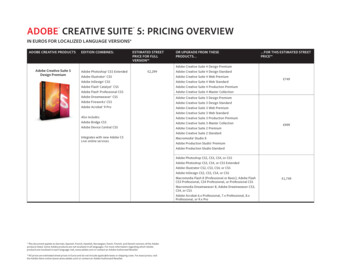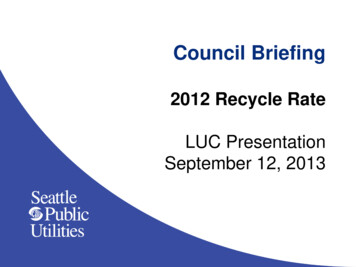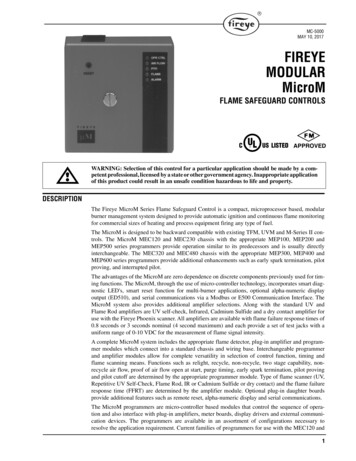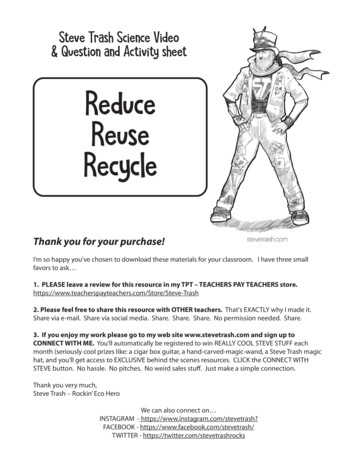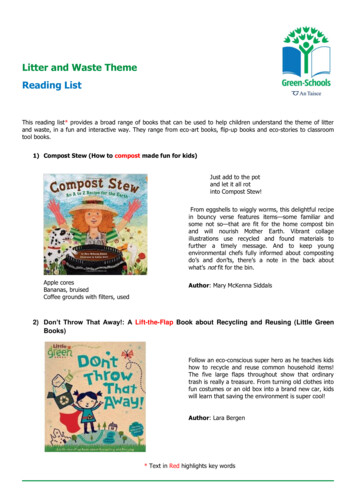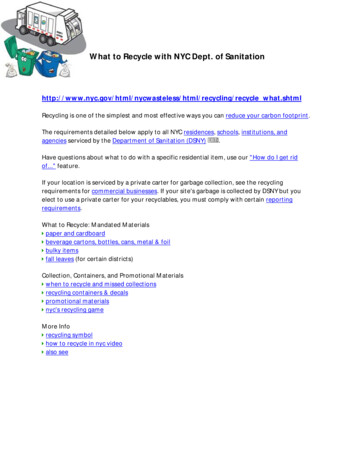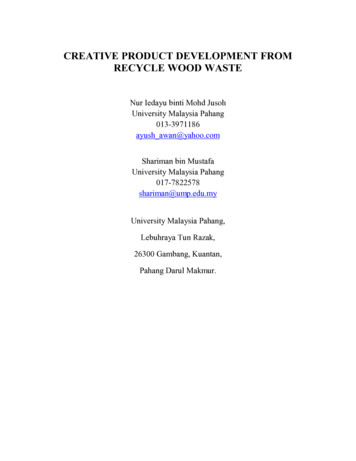
Transcription
CREATIVE PRODUCT DEVELOPMENT FROMRECYCLE WOOD WASTENur Iedayu binti Mohd JusohUniversity Malaysia Pahang013-3971186ayush awan@yahoo.comShariman bin MustafaUniversity Malaysia Pahang017-7822578shariman@ump.edu.myUniversity Malaysia Pahang,Lebuhraya Tun Razak,26300 Gambang, Kuantan,Pahang Darul Makmur.
CREATIVE PRODUCT DEVELOPMENT FROM RECYCLE WOOD WASTEABSTRACTWood waste refers to the end-of-life products, failed products, off cuts, shavings and sawdustof all timber products.[3] This excludes forest residues, often referred to as primary woodwaste. It also excludes green or garden waste materials such as branches, bushes and treestumps.[9] Wood waste can be reclaimed to become new product such as new table, door oranything. In general, current practice is that wood furniture’s that are no longer usable orbadly damaged will be thrown away. Notable example is the availability of damaged furniturefrom public buildings such schools, offices and various other public workplaces. Feasibilitystudy on reclaiming this valuable wood wastes resources are carefully discussed in this paper.Keyword: Wood waste, recycle, new product, green, furniture.
PROBLEM STATEMENTNow there are many types of wood or wooden things that are thrown away when it isdamaged or already too old. From our observation, wastes that are not widely reused are wood.The best example is availability of damaged furniture from schools like table, chair orcupboard. There must be a better way on how to reuse the wood to be transformed into a newapplication of product such as new door, new table and so on. In this way the waste dumpedaway as rubbish will be lesser, hence a plus point for better maintenance of our lovely naturalenvironment. In every country across the globe, there are tens of thousands of tons of oldwood and wood waste classified as hazardous, such as electric or telephone poles, sleepers,garden wood, structural timber, etc. The average useful life of these wooden poles isapproximately 35 years.[8] Recycling is an urgent matter as a result of changes in regulationswhich are forcing those operating the systems to find ways in dealing with these products witha view of recycling or reusing them. Recycling treated wood waste is problematic as itcontains polluting elements (chromium, copper, arsenic), which generally is classified ashazardous. This wood waste should neither be neglected nor be burnt in the open atmosphere.It must be collected and treated in the same way as the waste by which it wascontaminated.[8] Thus the holder and the producer of wood waste must disposed of this wasteproperly to avoid affecting human health and definitely our environment.
OBJECTIVEThe main purpose of this study is to reduce wood that are no longer in usedanymore. Public practice in generally is that most of used furniture that are no longer inservice or severely damaged will be discarded away. Most notable example is damagedfurniture at schools such as tables, chairs and cupboards. The damaged furniture often isplaced at the rear of buildings. Without proper recycling the furniture might eventually beburned away. In this project used furniture is valuable ingredient for making new furnitureproducts. Used furniture should be recycled so it won’t be left unattended such that theywould eventually become severely damaged or badly deteriorated and of little recycle value.PROJECT DESCRIPTIONRECYCLINGWhat is recycling? From Sir Jonathon Porritt on his speech on 2006 and The Leagueof Women Voters (1993) recycling involves processing of used materials (waste) into newproducts to prevent waste of potentially useful materials, reduce the consumption of fresh rawmaterials, reduce energy usage, reduce air pollution (from incineration) and water pollution(from land filling) by reducing the need for "conventional" waste disposal, andlower greenhouse gas emissions as compared to virgin production. Recycling is a keycomponent of modern waste reduction and is the third component of the "Reduce, Reuse, andRecycle" wastesystema good way of recycling.hierarchy.[1][2]Thebest way to ensure ourenvironment is
WOOD WASTE DEFINITION AND CLASIFICATIONThe NSW Department of Environment and Climate Change defines wood waste aswaste refers to the end-of-life products, failed products, off cuts, shavings and sawdust of alltimber products. This excludes forest residues, often referred to as primary wood waste. Italso excludes green or garden waste materials such as branches, bushes and tree stumps.Wood waste, then, is the waste from all timber products.[3]As state in J. Taylor and M. Warnke (2008) [3] and Matthew Warnken [9] there are threegroups of timber products:Untreated Timber Hardwood, many species Softwood, usually radiate pineEngineered Timber Products Particleboard Medium density fibreboard Plywood Low and high density fibreboard Oriented strand board Finger jointed timberTreated timbers Copper Chrome Arsenate (CCA) Light Organic Solvent Preservative (LOSP) Creosote preservative
TYPES OF WOODHARDWOODHardwood is wood from angiosperm trees (more strictly speaking non-monocotangiosperm trees). It may also be used for those trees themselves: these are usually broadleaved; in temperate and boreal latitudes they are mostly deciduous, but in tropics andsubtropics mostly evergreen. Hardwood contrasts with softwood (which comes from conifertrees). Hardwoods are not necessarily harder than softwoods. In both groups there is anenormous variation in actual wood hardness, with the range in density in hardwoodscompletely including that of softwoods; some hardwoods (e.g. balsa) are softer than mostsoftwoods, while yew is an example of hard softwood. The hardest hardwoods are muchharder than any softwood. There are about a hundred times as many hardwoods assoftwoods.[4]SOFTWOODSoftwood is the source of about 80% of the world's production of timber, withtraditional centres of production being the Baltic region (including Scandinavia and Russia)and North America. The term softwood is used as opposed to hardwood, which is the woodfrom angiosperm trees. Softwoods are not necessarily softer than hardwoods.[5] In bothgroups there is an enormous variation in actual wood hardness, with the range in density inhardwoods completely including that of softwoods; some hardwoods (e.g. balsa) are softerthan most softwoods, while the hardest hardwoods are much harder than any softwood; this isnot surprising as there are about a hundred times as many hardwoods as there aresoftwoods.[4] The woods of longleaf pine, douglas fir, and they are much harder in themechanical sense than several hardwoods.[6]
PROJECT PROCEDUREQUALITY FUNCTION DEPLOYMENT (QFD)One of the most important methods in product development and design is using QualityFunction Deployment (QFD) technique. QFD is a comprehensive quality system thatsystematically links the needs of the customer with various business functions andorganizational processes, such as marketing, design, quality, production, manufacturing, sales,etc., aligning the entire company toward achieving a common goal.QFD consists of: Understanding Customer Requirements Quality Systems Thinking Psychology Knowledge/Epistemology Maximizing Positive Quality That Adds Value Comprehensive Quality System for Customer Satisfaction Strategy to Stay Ahead of The GameAs a quality system that implements elements of Systems Thinking with elements ofPsychology and Epistemology (knowledge), QFD provides a system of comprehensivedevelopment process for: Understanding 'true' customer needs from the customer's perspective What 'value' means to the customer, from the customer's perspective Understanding how customers or end users become interested, choose,and are satisfied Analyzing how do we know the needs of the customer Deciding what features to include
Determining what level of performance to deliver Intelligently linking the needs of the customer with design, development,engineering, manufacturing, and service functions.[7]SURVEY OR QUESTIONNAIREFeedback from users, owner and furniture consumers is useful input in determiningwhat can be done with wood waste and how to improve the existing design model of furniturethat are derived from wood waste. The data collected during the survey must be carefullyanalyzed. SPSS is the intended computer software to be used for this project survey statisticalanalysis.CONCLUSIONRecycling is becoming an urgent matter as a result of changes in the regulations whichare forcing those operating the systems to find ways of dealing with these products with aview to recycle them.[8] The idea to use a wood waste as a main source in making a newproduct can help our country become cleaner and a more sustainable approach of environmentmanagement. This development also can be transformed into a new commercialindustry thus helping our country improve our economy further.
ReferencesAlise, Chantel (2010), How to Refurbish Furniture. Availablefrom:http://www.ehow.com/how 4423371 refurbishfurniture-.html [Accessed20/12/2010]BFM LtD. (2003), Wood Waste Recycling in Furniture Manufacturing – a good practiceguide.Bromhead, A. (2003) Reducing Wood Waste in Furniture Manufacture. Fauna & FloraInternational, Cambridge, U.K. Available from:http://www.globaltrees.org/downloads/reducing WW n furniture.pdf [Accessed17/01/2011]Cowan, Andrew and Arb, N.D. (2003) Decaying Wood, Recycling within Arboreal EcosystemAvailable from: ngdecaying wood.pdf [Accessed 16/01/2011].Crowson, Richard ed. (2006), The Handbook of Manufacturing Engineering 2nd Edition,Production Design & Factory Development, CRC Taylor and Francis Group, NewYork.Falk, Bob (1997), Wood Recycling – Opportunities for the wood waste resources (Volume 47,No. 6) pages 17-22.Fubra Limited (2003), The Guides Network is a trading style of Fubra Limited, hostedby CatN. Recycling Fact and Figures Available from: http://www.recyclingguide.org.uk/facts.html [Accessed 20/12/2010].Powazek, Derek (2009), Eco-Friendly – Refurbished Furniture! Available 1/06/ecofriendly-refurbished-furniture/[Accessed 20/12/2010].Ulrich, Karl and Eppinger, Steven (2003), Product Design and Development 3rd Edition.McGraw Hill, New York.Williamson, Thomas G., ed. (2002) APA ENGINEERING WOOD HANDBOOK, McGraw–Hill Handbook, New York.
[1] "PM's advisor hails recycling as climate change action.". Letsrecycle.com. 2006-11-08.Retrieved 2010 06-19.[2] a b c d e f g h i j k l m n o p q r s t u v The League of Women Voters (1993). The GarbagePrimer. New York: Lyons & Burford. pp. 35–72. ISBN 1558218507.[3] J. Taylor and M. Warnke (2008), Wood recovery and recycling: A source book forAustralia, Prepared for Forest & Wood Products Australia [Assessed on 14/12/2010][4] Wikipedia the free encyclopedia, http://en.wikipedia.org/wiki/Hardwood [Accessed on14/12/2010][5] International timber, wood the way you want /2/softwoods/ [Accessed 0n14/12/2010][6] Wikipedia the free encyclopedia, http://en.wikipedia.org/wiki/Softwood [Accessed on14/12/2010][7] QFD Institute, the official sources for QFD,http://www.qfdi.org/what is qfd/what is qfd.html [Accessed on 14/12/2010][8] Thermya SA, 2006, what to do with wood waste?.http://www.thermya.com/en/index thermya.php?id 15 [Accessed on 14/12/2010][9] Matthew Warnken, Western Sydney Waste Board, Problematic Wood Waste In RecycledOrganic Material.
CREATIVE PRODUCT DEVELOPMENT FROM RECYCLE WOOD WASTE Nur Iedayu binti Mohd Jusoh University Malaysia Pahang 013-3971186 ayush_awan@yahoo.com Shariman bin Mustafa . Wood waste refers to the end-of-life products, failed products, off cuts, shavings and sawdust of all timber products.[3]



